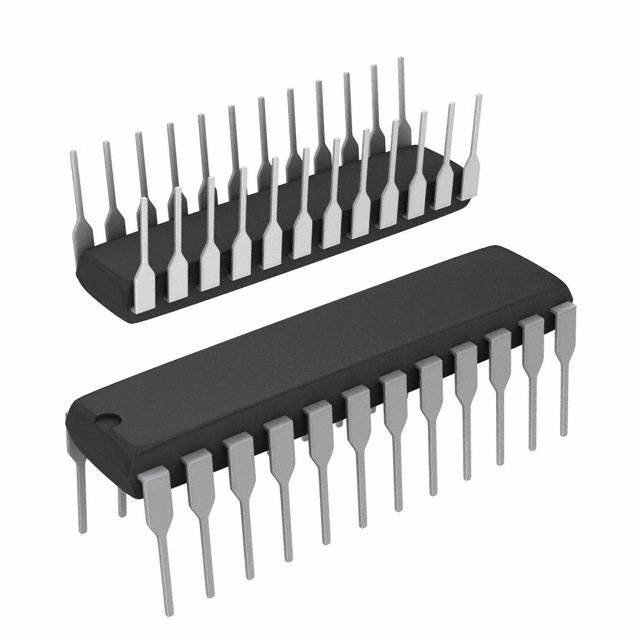Viz Specifikace pro podrobnosti o produktu.

AD5204BN100
Product Overview
- Category: Integrated Circuit (IC)
- Use: Digital Potentiometer
- Characteristics: 4-channel, 256-position, non-volatile memory
- Package: DIP (Dual Inline Package)
- Essence: Provides digital control of resistance values
- Packaging/Quantity: Tube packaging, 25 pieces per tube
Specifications
- Number of Channels: 4
- Resolution: 8 bits (256 positions)
- Resistance Range: 0 to 100 kΩ
- Interface: Serial Peripheral Interface (SPI)
- Supply Voltage: 2.7V to 5.5V
- Temperature Range: -40°C to +125°C
Detailed Pin Configuration
The AD5204BN100 has a total of 16 pins, which are assigned as follows:
- VSS: Ground
- RDY/BSY: Ready/Busy Indicator
- SDO: Serial Data Output
- SDI: Serial Data Input
- SCLK: Serial Clock Input
- CS: Chip Select Input
- HIZ: High Impedance Terminal
- VDD: Positive Power Supply
- A1: Channel 1 Terminal A
- W1: Channel 1 Terminal W
- B1: Channel 1 Terminal B
- A2: Channel 2 Terminal A
- W2: Channel 2 Terminal W
- B2: Channel 2 Terminal B
- A3: Channel 3 Terminal A
- W3: Channel 3 Terminal W
Functional Features
- Non-volatile Memory: The AD5204BN100 retains its settings even when power is removed.
- Digital Control: Allows precise and accurate adjustment of resistance values.
- Low Power Consumption: Operates with minimal power requirements.
- SPI Interface: Enables easy integration with microcontrollers and other digital systems.
Advantages and Disadvantages
Advantages: - High resolution and accuracy - Non-volatile memory ensures settings are retained - Easy to interface with digital systems - Low power consumption
Disadvantages: - Limited resistance range (0 to 100 kΩ) - Requires external microcontroller or digital system for control
Working Principles
The AD5204BN100 is a digital potentiometer that replaces traditional mechanical potentiometers. It consists of a series of resistive elements connected in a ladder-like configuration. By digitally controlling the switches between these resistive elements, the desired resistance value can be achieved.
The potentiometer's resistance value is adjusted by sending commands through the SPI interface. The non-volatile memory ensures that the resistance settings are retained even when power is removed.
Detailed Application Field Plans
The AD5204BN100 finds applications in various fields, including:
- Audio Equipment: Volume control, tone adjustment, and equalization circuits.
- Instrumentation: Calibration and signal conditioning circuits.
- Industrial Control Systems: Precise control of parameters such as temperature and pressure.
- Test and Measurement Equipment: Programmable resistance loads and attenuators.
- Communication Systems: Signal level adjustment and impedance matching.
Detailed and Complete Alternative Models
- AD5206: 6-channel digital potentiometer with similar specifications.
- MCP4131: 4-channel digital potentiometer with different package options.
- MAX5481: 4-channel digital potentiometer with higher resolution.
(Note: This list is not exhaustive and there are several other alternative models available in the market.)
In conclusion, the AD5204BN100 is a 4-channel digital potentiometer that provides precise and accurate control of resistance values. Its non-volatile memory, low power consumption, and easy interface make it suitable for various applications in audio equipment, instrumentation, industrial control systems, test and measurement equipment, and communication systems.
Seznam 10 běžných otázek a odpovědí souvisejících s aplikací AD5204BN100 v technických řešeních
Sure! Here are 10 common questions and answers related to the application of AD5204BN100 in technical solutions:
Q: What is AD5204BN100? A: AD5204BN100 is a digital potentiometer IC (integrated circuit) with four channels, each having a 100kΩ resistance.
Q: How can I control AD5204BN100? A: AD5204BN100 can be controlled using a microcontroller or any other digital interface that supports SPI (Serial Peripheral Interface) communication.
Q: What are the typical applications of AD5204BN100? A: AD5204BN100 is commonly used in applications such as volume control, gain adjustment, calibration, and programmable voltage dividers.
Q: Can AD5204BN100 replace mechanical potentiometers? A: Yes, AD5204BN100 can be used as a replacement for mechanical potentiometers, providing digital control and eliminating issues like wear and tear.
Q: What is the resolution of AD5204BN100? A: AD5204BN100 has a resolution of 256 steps, allowing for precise adjustments in resistance values.
Q: What is the power supply range for AD5204BN100? A: AD5204BN100 operates within a power supply range of 2.7V to 5.5V.
Q: Can AD5204BN100 handle high currents? A: No, AD5204BN100 is designed for low current applications. It can typically handle currents up to 1mA.
Q: Is AD5204BN100 suitable for audio applications? A: Yes, AD5204BN100 is commonly used in audio applications for volume control and audio signal routing.
Q: Can I daisy-chain multiple AD5204BN100 ICs together? A: Yes, AD5204BN100 supports daisy-chaining, allowing you to control multiple ICs using a single SPI interface.
Q: Are there any evaluation boards available for AD5204BN100? A: Yes, Analog Devices provides evaluation boards for AD5204BN100, which can help in prototyping and testing the IC in various applications.
Please note that these answers are general and may vary depending on specific requirements and use cases.

